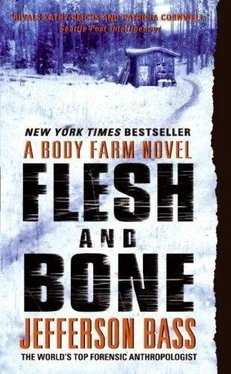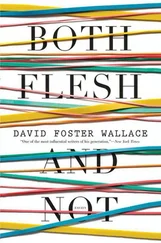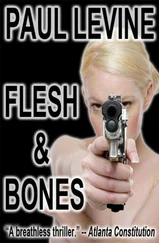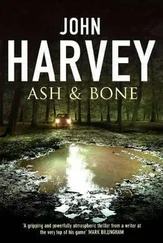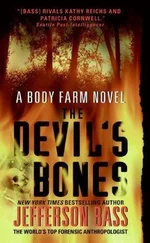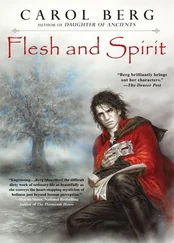Jefferson Bass - Flesh and Bone - A Body Farm Novel
Здесь есть возможность читать онлайн «Jefferson Bass - Flesh and Bone - A Body Farm Novel» весь текст электронной книги совершенно бесплатно (целиком полную версию без сокращений). В некоторых случаях можно слушать аудио, скачать через торрент в формате fb2 и присутствует краткое содержание. Год выпуска: 2007, Жанр: Детектив, на английском языке. Описание произведения, (предисловие) а так же отзывы посетителей доступны на портале библиотеки ЛибКат.
- Название:Flesh and Bone: A Body Farm Novel
- Автор:
- Жанр:
- Год:2007
- ISBN:нет данных
- Рейтинг книги:3 / 5. Голосов: 1
-
Избранное:Добавить в избранное
- Отзывы:
-
Ваша оценка:
- 60
- 1
- 2
- 3
- 4
- 5
Flesh and Bone: A Body Farm Novel: краткое содержание, описание и аннотация
Предлагаем к чтению аннотацию, описание, краткое содержание или предисловие (зависит от того, что написал сам автор книги «Flesh and Bone: A Body Farm Novel»). Если вы не нашли необходимую информацию о книге — напишите в комментариях, мы постараемся отыскать её.
Flesh and Bone: A Body Farm Novel — читать онлайн бесплатно полную книгу (весь текст) целиком
Ниже представлен текст книги, разбитый по страницам. Система сохранения места последней прочитанной страницы, позволяет с удобством читать онлайн бесплатно книгу «Flesh and Bone: A Body Farm Novel», без необходимости каждый раз заново искать на чём Вы остановились. Поставьте закладку, и сможете в любой момент перейти на страницу, на которой закончили чтение.
Интервал:
Закладка:
Now, years later, most crime scene techs knew to collect the largest maggots they could find on a body, as those would probably have hatched from the earliest flies to find the body. By collecting and preserving those maggots and sending them to a forensic entomologist, the crime scene techs could get a pretty good idea how long ago the murder had occurred. The best-trained techs would also keep a few of the largest maggots alive, and make careful note of when they encased themselves in a pupa case, or puparium-the inelegant maggot’s version of a caterpillar’s cocoon-and record when the metamorphosis into the adult insect occurred. The only difference was that instead of a beautiful butterfly emerging from its cocoon, what would emerge from the puparium would be a young blowfly, which would promptly home in on the body, too, if the body were still there. So far, Jess said, none of the live maggots collected from the body had pupated yet. That meant, if the collected specimens did indeed represent the earliest fly hatch, the murder had occurred less than fourteen days ago.
Even from several feet away, I could see the dark stain at the base of the tree, marking where volatile fatty acids had leached from the body as it began to decay. Drawing closer, I thought I saw the first piece of additional evidence I was hoping to see: a faint line of stain leading from the base of the tree into the edge of the woods. The crime scene report had given me reason to hope I would see this.
“Sharp eye, wrong interpretation,” I muttered.
“How’s that?” I had forgotten the forester was with me.
“Oh, sorry,” I said, “I was talking to myself. You see this faint trail of dark fluids?”
“Yeah,” he said. “A drag mark. One of the crime scene guys pointed it out to me. Said it showed the killing occurred over there at the edge of the woods-said that was the primary death scene, and the tree here was really the secondary death scene.”
“I don’t think so,” I said. “You see how the stain is darkest here at the tree, then fades as it leads over there?”
He studied the faint trail. “Maybe, now that you mention it. So what?”
“What I think we’re looking at here is a maggot trail.”
“A maggot trail?”
“Sometimes, when the maggots get ready to cocoon and turn into flies, they crawl away from the body to find a more protected place. Probably so they won’t get gobbled up by birds. And for reasons we don’t understand, when they do that, they all tend to head in the same damn direction, like a herd of sheep or cows, or a bunch of lemmings.”
“Huh,” was all he said.
“The reason the trail gets fainter as it leads away from the body is that they’re coated with goo from the body at first.”
“Goo?”
“Goo. That’s a technical term we Ph.D.’s like to throw around to impress folks,” I said. “More or less interchangeable with ‘gack.’ Also with ‘volatile fatty acids.’ Anyhow, they’re all greasy with goo when they first crawl off to cocoon, but as they wiggle along the ground, the goo gets wiped off, leaving that trail we see. But by the time they get where they’re going, sometimes they’re scrubbed off enough that they’ve stopped leaving a trail. I bet if we head in that direction, though, we can find where they ended up.”
The trail of dark stain led to the west, in a remarkably straight line about a foot wide, so I followed it into the edge of the woods. Within a few feet it began to fade dramatically, so I dropped to all fours again and crawled along through the brush. Cliff followed me upright. Just when I reached a thicket of mountain laurel that seemed impenetrable, I began to see them, mostly tucked under a protective layer of last fall’s leaves. I beckoned Cliff closer and pointed. “You see those little torpedo-shaped things, about a quarter inch long?”
He frowned, squatted down, and then said, “Oh yeah, dark brown? With little rings around ’em? What are they?”
I picked up one with my right thumb and forefinger, taking care not to crush it, and cradled it in the palm of my left hand. One end had a small round opening, revealing the cylinder’s hollow interior. “It’s a puparium-a pupa case. This one’s empty, which means the fly has already chewed his way out. So that means the body was out here at least two weeks ago.”
“So you’re saying these things tell you that the murder occurred maybe just a few days after I was out here?”
“Looks that way to me,” I said. Taking a small vial from my shirt pocket, I flipped off the cap with my thumb and tipped in the puparium from my cupped palm. Then I plucked several more from the ground, snapped the lid closed, and buttoned the vial into my shirt. “We’ve re-created the death scene at my research facility up at UT-Knoxville, using a donated cadaver. It’s been tied to a tree for nearly a week now, and it’s starting to reach the same stage of decay as the body here was in when it was found. So that argues for the same timetable.”
Out of the corner of my eye, I caught a tiny movement among the leaves. I looked down in time to see a tiny fly, newly hatched, crawl onto a reddish brown leaf from a chestnut oak. It joined several others already on the leaf ’s broad surface, which was catching the afternoon sun. I pointed to them, and Cliff leaned down for a look. I waved a finger above them; they scuttled to and fro, trying to get away, but remained on the leaf rather than flying away. “When they first hatch,” I explained, “their wings are still damp and soft. They have to dry awhile before they’re stiff enough for flight. If you look around on some of the tree trunks here, you might see a bunch more. Once I worked a death scene where the south-facing wall of a building was covered with thousands of little flies, all drying their wings.”
He scouted around, then called my attention to a couple of tree trunks. “Not thousands, but probably hundreds on these two trees.” I nodded. He looked thoughtful. “So next time I bring my lunch out here,” he said, “these guys are gonna be all over me, huh?”
“Some of them,” I said. “Unless they’ve caught wind of something, or somebody, that smells more interesting someplace else.”
“And these came from the maggots that were feeding on the body, right?”
“I think so,” I answered. “What do you think?”
“I think it’s time to find myself another lunch spot.”
I retraced my steps to the tree where the body had been lashed. Stooping down, hands on knees, I scanned the ground. I didn’t see what I was seeking, so again I dropped to my hands and knees and began crawling outward from the base of the tree in a series of ever-widening arcs.
“What are you looking for now?”
Just as I was about to say it wasn’t there, I spotted what appeared to be a shriveled, curled leaf sitting by itself atop the carpet of moss and pine needles. “This, I think,” I answered. I picked it up and rolled it between two fingers, gently but with enough pressure to crumble a dead leaf. It did not crumble. I uncurled it ever so slightly and held it up to the light. The sun shone through it, giving it an amber glow, and in that glow I could discern a pattern of creases and swirls I would recognize anywhere.
I walked over to Cliff, bearing it like some holy relic. In a way, it was: the identity, potentially, of the young man who had been beaten to death here in this spot. I held it up to the light so he could look through it. He studied it, frowning, and then a look of understanding and wonder dawned on his face. “Looks like fingerprints,” he said. I nodded. The frown returned. “But how…?”
“About a week after death, the outer layer of skin-the epidermis-sloughs off of the hands,” I explained. “It comes loose from the underlying layer, the dermis, and peels off almost like a surgical glove. I can take this back to the lab, soak it in water and fabric softener overnight, and tomorrow morning somebody in the crime lab can put his fingers inside these fingers-put this glove on his hands-and get a set of prints.”
Читать дальшеИнтервал:
Закладка:
Похожие книги на «Flesh and Bone: A Body Farm Novel»
Представляем Вашему вниманию похожие книги на «Flesh and Bone: A Body Farm Novel» списком для выбора. Мы отобрали схожую по названию и смыслу литературу в надежде предоставить читателям больше вариантов отыскать новые, интересные, ещё непрочитанные произведения.
Обсуждение, отзывы о книге «Flesh and Bone: A Body Farm Novel» и просто собственные мнения читателей. Оставьте ваши комментарии, напишите, что Вы думаете о произведении, его смысле или главных героях. Укажите что конкретно понравилось, а что нет, и почему Вы так считаете.
